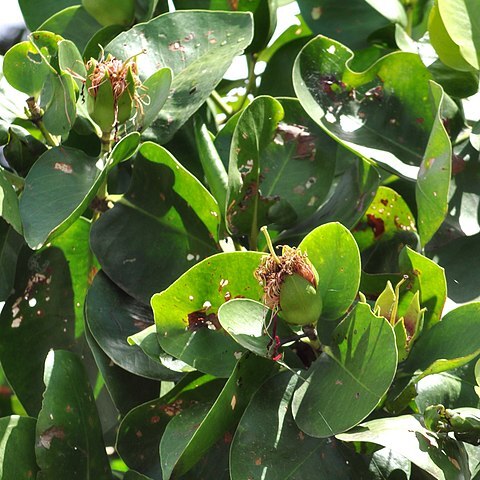A small tree. It grows up to 10-20 m high. The trunk is 20-35 cm across. It forms branches low down. It has aerial roots. The bark is similar to guava. Young branches are 4-angled. The leaves are simple and produced opposite one another. The leaf is rounded and notched around the edge. Leaves are 4-8 cm long by 3-7 cm wide. There are 12-14 pairs of side veins. The veins are fine but distinct on both sides of the leaf surface. The leaf stalk is 4-6 mm long. The flowers occur in a flat topped arrangement at the end of branches. Three flowers occur together. The bud is rounded at the top and has small dots. The flower tube has 6 lobes. The flower does not have petals. The fruit is a berry 3-4 cm across and 2-3 cm high. The sepals hang on the fruit enabling it to float. The fruit are edible.
Trees, columnar, to 10(-20) m tall. Pneumatophores ca. 20 cm, thin, pointed. Petiole 5-6 mm; leaf blade broadly ovate to suborbicular, 4-10 × 3-9 cm, base broadly rounded or subcordate, apex rounded, mucro absent. Flowers mostly 6-merous. Floral tube 2-3 cm at anthesis, finely verruculose, 6-ribbed, ribs decurrent along stipitate base; sepals adaxially strongly tinged red, ca. 1.5 cm, often appressed against mature fruit. Petals generally absent, rarely vestigial, white, linear. Staminal filaments white. Fruit 3-4.5 cm in diam., ca. equal to width of floral tube. Fl. Mar-Oct, fr. Apr-Oct. 2n = 22, 24.


